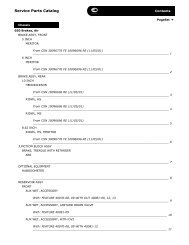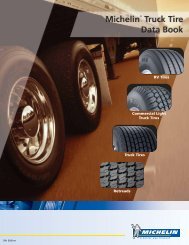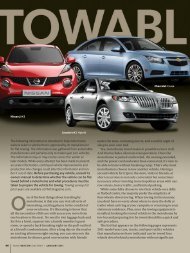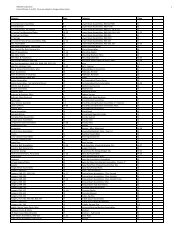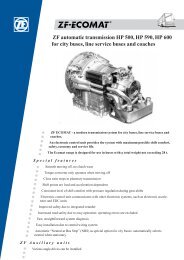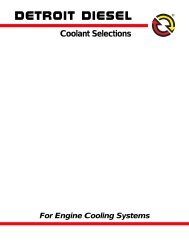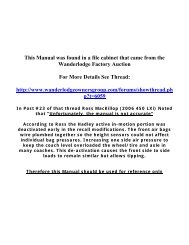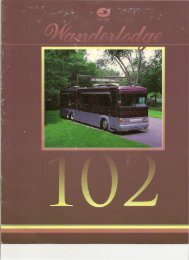Propane Tank OPD Exemption - Wanderlodge Owners Group
Propane Tank OPD Exemption - Wanderlodge Owners Group
Propane Tank OPD Exemption - Wanderlodge Owners Group
Create successful ePaper yourself
Turn your PDF publications into a flip-book with our unique Google optimized e-Paper software.
The above NO <strong>OPD</strong> sticker is available at;<br />
http://www.pbase.com/image/75453477<br />
What follows is a draft of an email and the reply to it, that I had sent to the National Fire Protection Association<br />
(NFPA), concerning the problems that some Bluebird <strong>Wanderlodge</strong> owners including myself have encountered in<br />
getting the propane tanks installed on our Bluebird <strong>Wanderlodge</strong> filled at some <strong>Propane</strong> filling stations<br />
throughout the country.<br />
I have also included in this file some excerpts and URL links from different web sites that concern this topic. I am<br />
also in the process of having a sticker similar to the one above made, that can be placed in such a manner on<br />
these tanks, so that the <strong>Propane</strong> filling station attendant can see that this code does not apply to the tank.<br />
The spelling in Mr. Lemoff’s reply to my email enquiry, is his own. I have not edified the content other than to<br />
highlight the text that refers to the <strong>Propane</strong> tanks installed on our Bluebird <strong>Wanderlodge</strong>s.<br />
Dear Mr. Finn,<br />
This is in response to your question on NFPA 58, regarding filling of RV propoane fuel containers. The <strong>OPD</strong> exemption you<br />
refer to applies to cylinders, and not permanenty installed engine fue and mobile containers. I refer you to Chapter 11, Engine<br />
Fuel Systems. Paragraph 11.4.1.13 states: 11.4.1.13 Containers fabricated after January 1, 1984, for use as engine fuel<br />
containers on vehicles shall be equipped or fitted with an overfilling prevention device.<br />
11.4.1.14 Where an overfilling prevention device is installed on the container or exterior of the compartment and remote filling<br />
is used, a double backflow check valve shall be installed in the container fill valve opening.<br />
11.4.1.15 Where an overfilling prevention device is installed on an engine fuel container, venting of gas through a fixed<br />
maximum liquid level gauge during normal filling shall not be required.<br />
Any RV with a permanently installed propoane continer manufactured in 1984 or later will have an <strong>OPD</strong> installed, and can be<br />
filled. Permanently installed continers manufactured before1984 are not required to have an <strong>OPD</strong>. To summarize, the <strong>OPD</strong><br />
requirements that have been publicised are for Cylinders only, and not for permanetly installed RV containers.<br />
This correspondence is not a Formal Interpretation issued pursuant to NFPA Regulations. Any opinion expressed is the<br />
personal opinion of the author, and does not necessarily represent the official position of the NFPA or its Technical<br />
Committees. In addition, this correspondence is neither intended, nor should be relied upon, to provide professional<br />
consultation services.<br />
Very truly yours,<br />
Theodore C. Lemoff<br />
Staff Liaison<br />
From: Maynard, Mary<br />
Sent: Mon 3/5/2007 8:27 AM<br />
To: NFPA58@nfpa.org<br />
Subject: FW: RV PROPANE TANK CODES
From: IAMFLAGMAN@aol.com [mailto:IAMFLAGMAN@aol.com]<br />
Sent: Sunday, March 04, 2007 9:44 PM<br />
To: Maynard, Mary<br />
Subject: RV PROPANE TANK CODES<br />
My name is John Finn and I'm a moderator on an Internet forum for the Bluebird <strong>Wanderlodge</strong> Motorcoach<br />
owners at; http://autos.groups.yahoo.com/group/wanderlodge/<br />
One of the questions that comes up every so often is some of our members are having a difficult time getting<br />
their over 40 gallon, not 40 pound sized propane tanks filled.<br />
I have gone to your web site for the code:<br />
http://www.nfpa.org/freecodes/free_access_document.asp<br />
Review NFPA 58: Liquefied Petroleum Gas Code, 2004 Edition online<br />
I can't find the actual section that covers what I understand is an <strong>OPD</strong> exemption for the propane tanks that are<br />
horizontally mounted permanently on our <strong>Wanderlodge</strong>. I have found this information with a reference to THE<br />
CODE on web sites such as;<br />
http://www.npga.org/i4a/pages/index.cfm?pageid=534<br />
Which says;<br />
Q: I have a horizontal cylinder on my recreational vehicle. Are <strong>OPD</strong>'s available for that kind of service? :<br />
A: The 2001 edition of NFPA 58 (the LP-Gas Code) recognizes that horizontally oriented cylinders that were<br />
manufactured prior to October 1, 1998, are unable to be retrofitted with the <strong>OPD</strong>'s. As a result of this fact, the<br />
Code now exempts these cylinders from having to be retrofit with <strong>OPD</strong> valves. Any such cylinder must have a<br />
label affixed to it to inform the user and the refiller that an <strong>OPD</strong> valve is not installed.<br />
Could you please tell me where to actually find this information in the code. I will then place the URL link to that<br />
section of the code in our files for our members to read. I understand that I cannot copy and paste any portion of<br />
the online version of the code, is there anywhere that I can obtain just that section of the code that pertains to<br />
the tanks on our <strong>Wanderlodge</strong>'s. We would like to carry a copy of this section with us, to show to the propane<br />
suppliers that are refusing to fill our tanks without the <strong>OPD</strong>'s installed.<br />
Thank you very much for your assistance.<br />
John Finn<br />
Forum Moderator<br />
<strong>Wanderlodge</strong>s <strong>Owners</strong> <strong>Group</strong><br />
http://autos.groups.yahoo.com/group/wanderlodge/<br />
'82 35FCRB<br />
BLUEBIRD WANDERLODGES<br />
TO VISIT THE "FINN'S INN EXPRESS" REMODELING ADVENTURE<br />
GO TO;<br />
http://www.pbase.com/image/24977457<br />
HOPKINS, SOUTH CAROLINA
RV camping wisdom from the experts at KOA.<br />
Important Information On Your RV <strong>Propane</strong> <strong>Tank</strong><br />
Is it time to retire your propane tank?<br />
Beginning April 1, you will no longer be able to get your small propane tank refilled without an overfilling<br />
protection device (<strong>OPD</strong>) installed.<br />
This means anyone with a tank manufactured before Oct. 1, 1998 will have to have the tank valve unit replaced,<br />
or purchase a new tank. The new rules apply to all small propane tanks with a capacity of from 4 pounds up to 40<br />
pounds of propane. Those tanks are common on gas grills and recreational vehicles.<br />
The overfilling protection device is being required in order to comply with national fire and safety standards.<br />
There are limits on how much propane can be put into a cylinder. A properly filled cylinder will have a vapor<br />
space left at the top to allow room for expansion of the liquid when a change in temperature occurs. The <strong>OPD</strong> is<br />
a secondary means of insuring that cylinders are not overfilled.<br />
The <strong>OPD</strong> is needed because overfilled cylinders, when subjected to warmer temperatures, create hazardous<br />
conditions. The pressure relief value may open, discharging propane from the cylinder, or liquid propane may<br />
enter your RV’s piping system, resulting in higher than normal pressures to appliances.<br />
The <strong>OPD</strong> is basically a value that includes a float inside the tank that will automatically close the cylinder when<br />
the proper level of propane is reached.<br />
You can take your old propane tanks to a propane dealer to have an <strong>OPD</strong> installed, but due to the cost you may<br />
be better off purchasing a new tank.<br />
If you’re wondering if your current tank has an <strong>OPD</strong> installed, check the value. If the value has a triangular hand<br />
wheel that is stamped with the letters <strong>OPD</strong> you have an approved cylinder.<br />
http://www.koa.com/familyzone/camping101/articles/safety_540.htm
<strong>OPD</strong>'s: Information for Consumers -<br />
Questions & Answers<br />
An Avenue to Greater Safety in the<br />
Use of <strong>Propane</strong><br />
This information has been developed to create a better understanding relative to the introduction of a new safety<br />
device designed to markedly increase the safe use of small propane cylinders. While an occasional<br />
inconvenience may occur during the transition to a higher level of propane safety for gas grill tanks, etc., it is the<br />
propane industry's desire that the <strong>OPD</strong> be recognized by consumers for what it really is...a notable advancement<br />
for the safe use of the Exceptional Energy, <strong>Propane</strong>!<br />
Here then, is a listing of answers to consumer's most commonly asked questions. The propane industry hopes<br />
that this information will be helpful relative to the purpose and use of the overfilling prevention device.<br />
The <strong>OPD</strong><br />
What is an overfilling prevention device?<br />
What does the Code require?<br />
How can an <strong>OPD</strong> be identified when it is installed in a cylinder?<br />
Is an <strong>OPD</strong> intended to be an aid in the filling of a cylinder?<br />
Is the requirement for <strong>OPD</strong>'s a mercenary ploy by those in the propane industry to take advantage of consumer's<br />
pocketbooks?<br />
I have a horizontal cylinder on my recreational vehicle. Are <strong>OPD</strong>'s available for that kind of service? :<br />
Why do some propane retail marketers fill cylinders that would normally be required to be requalified and have<br />
an <strong>OPD</strong> installed, whereas other marketers require the <strong>OPD</strong> to be retrofit on the cylinder before they refill it?<br />
If the requirement for a cylinder to be equipped with an <strong>OPD</strong> is not a law in my state, then how can it be enforced<br />
by a propane marketer?<br />
What happens if the float breaks off?<br />
In another state I recently had a cylinder filled for my deer hunting camp and they didn't mention anything about<br />
an <strong>OPD</strong>. Are there laws different from this state?<br />
Why don't they make one-time-use throw-away grill tanks?<br />
Where can I have my tank requalified and a new <strong>OPD</strong> valve installed? If you will not requalify my tank, then where<br />
can I buy a new one? Where can I dispose of my old tank?<br />
Roofers and other commercial customers are trying to use <strong>OPD</strong> equipped tanks on torch applications and they<br />
are not getting an adequate flow through the valve. What can we do about this?<br />
Q: What is an overfilling prevention device?<br />
A: As defined by the National Fire Protection Association's Pamphlet 58 - LP-Gas Code, 1998 Edition (Code), it<br />
is...'A safety device that is designed to provide an automatic means to prevent the filling of a container in excess<br />
of the maximum permitted filling limit.' Typically, the overfilling prevention device will appear as part of a<br />
cylinder valve that is installed as a complete unit into the cylinder. The cylinder valve will have either a CGA 791<br />
(ACME threads) or a CGA 810 (push-pull, quick disconnect) connection device.<br />
Q. What does the Code require?<br />
A. For propane cylinders* in the 4 lb. through 40 lb. propane capacity range, the Code requires for them to be<br />
equipped with an <strong>OPD</strong>, as follows: New cylinders for vapor service which are fabricated after September 30,<br />
1998; as cylinders are requalified after September 30, 1998 through March 31, 2002; effective April 1, 2002, before<br />
a cylinder is filled. *All references to 'cylinders' applies to only those in the 4 lb. through 40 lb. propane capacity
ange. Also, the last page of this document contains information on the service life and inspection of cylinders.<br />
Q: How can an <strong>OPD</strong> be identified when it is installed in a cylinder?<br />
A: Listed (e.g. Underwriters Laboratories, Inc.) <strong>OPD</strong>'s are easily recognizable by observing their unique trilobular<br />
handwheel. The hand wheel is connected to the valve stem in a tamperproof manner for the purpose reducing<br />
the possibility of putting a user at risk by an attempt to interchange an <strong>OPD</strong> handwheel on to a conventional<br />
non-<strong>OPD</strong> valve. It should be noticed that the valve stem on a non- <strong>OPD</strong> equipped cylinder is not easily matched<br />
with a standard trilobular <strong>OPD</strong> handwheel. Those who fill cylinders should take care in observing whether or not<br />
a cylinder that appears to be equipped with an <strong>OPD</strong>, actually is.<br />
Q:Is an <strong>OPD</strong> intended to be an aid in the filling of a cylinder?<br />
A: The device is designed to only be a backup in the filling of a cylinder. With an <strong>OPD</strong> equipped cylinder, the<br />
traditional procedures of filling by the weight or volumetric methods should be followed.<br />
Note - Prior to the Code's requirement for the use of <strong>OPD</strong>'s, early non-uniform valves were introduced into the<br />
marketplace. Thousands of these valves had conventional hand wheels and were not marked as now required by<br />
the UL listing. While the safety features of these early <strong>OPD</strong> valves is not being questioned, those who fill small<br />
propane cylinders should be aware of these valves still being in service. In time, through normal attrition, these<br />
first generation <strong>OPD</strong> valves will fade from use by attrition.<br />
Q: Is the requirement for <strong>OPD</strong>'s a mercenary ploy by those in the propane industry to take advantage of<br />
consumer's pocketbooks?<br />
A: This is a good question and deserves a direct answer which is...no. Those marketers who fill propane<br />
cylinders for customers have had virtually nothing to do with the advent of the <strong>OPD</strong>. The term 'virtually' is used<br />
as there were a few highly concerned and industry active propane marketers who became involved in resolving<br />
issues which surrounded the advent of <strong>OPD</strong>'s, including a reasonable time frame for the introduction of these<br />
new safety devices into the marketplace.<br />
Q: I have a horizontal cylinder on my recreational vehicle. Are <strong>OPD</strong>'s available for that kind of service? :<br />
A: The 2001 edition of NFPA 58 (the LP-Gas Code) recognizes that horizontally oriented cylinders that were<br />
manufactured prior to October 1, 1998, are unable to be retrofitted with the <strong>OPD</strong>'s. As a result of this fact, the<br />
Code now exempts these cylinders from having to be retrofit with <strong>OPD</strong> valves. Any such cylinder must have a<br />
label affixed to it to inform the user and the refiller that an <strong>OPD</strong> valve is not installed.<br />
Q: Why do some propane retail marketers fill cylinders that would normally be required to be requalified and<br />
have an <strong>OPD</strong> installed, whereas other marketers require the <strong>OPD</strong> to be retrofit on the cylinder before they refill it?<br />
A: <strong>Propane</strong> marketers of integrity are those that care about the handling and use of cylinders that they refill,<br />
knowing that the families of consumers deserve the best and safest service that can be offered. If a propane<br />
marketer elects to do otherwise, that choice speaks for itself. Also keep in mind that some states or jurisdictions<br />
have not adopted the 1998 or later editions of NFPA 58.<br />
Q:If the requirement for a cylinder to be equipped with an <strong>OPD</strong> is not a law in my state, then how can it be<br />
enforced by a propane marketer?<br />
A: The Code is not adopted, state-by-state, on a uniform basis. In time, most states, if not all, will move to<br />
enforce the <strong>OPD</strong> criteria which was first published in the Code's 1998 edition.<br />
Q: What happens if the float breaks off?<br />
A: If an <strong>OPD</strong> is determined to inoperable, it should be replaced.<br />
Q: In another state I recently had a cylinder filled for my deer hunting camp and they didn't mention anything<br />
about an <strong>OPD</strong>. Are there laws different from this state?<br />
A. The Code is revised by the National Fire Protection Association every three years. Virtually all of the individual<br />
United States of America have adopted the Code as their rules for propane applications, but not necessarily on a<br />
uniform basis as to a particular edition. So, as the <strong>OPD</strong> requirements first appeared in the 1998 edition of the<br />
Code, not all states have updated their propane rules to that edition. Again, it is expected that all cylinders in the<br />
4 lb. through 40 lb. capacity range will eventually be equipped with an <strong>OPD</strong>.<br />
Q: Why don't they make one-time-use throw-away grill tanks?<br />
A: <strong>Propane</strong> cylinders are manufactured to a comprehensive specification of the U.S. Department of<br />
Transportation. Because of these strict requirements, a throwaway grill tank service would increase consumer<br />
cost to a level that would be unreasonable and impractical.
Q: Where can I have my tank requalified and a new <strong>OPD</strong> valve installed? If you will not requalify my tank, then<br />
where can I buy a new one? Where can I dispose of my old tank?<br />
A: The propane marketers serving your area should be a reliable source of information to answer questions<br />
regarding the <strong>OPD</strong>.<br />
Q: Roofers and other commercial customers are trying to use <strong>OPD</strong> equipped tanks on torch applications and<br />
they are not getting an adequate flow through the valve. What can we do about this?<br />
A: Some of the early <strong>OPD</strong> valves had an insufficient flow capacity for certain types of service such as<br />
high-pressure torch applications. Market competition has resulted in <strong>OPD</strong>'s becoming available that have<br />
significantly greater rates of flow.<br />
©NPGA 2002<br />
http://www.npga.org/i4a/pages/index.cfm?pageid=534<br />
The following draft of another email correspondence with Mr. Lemoff, is in reference to a similar problem with<br />
the <strong>Propane</strong> filling station attendant that tells you that the tank on your Bluebird <strong>Wanderlodge</strong>, is too old and<br />
needs to be re-certified. Again I have not edited the content of his email, but I have highlighted the sections that I<br />
feel are pertaining to our Bluebird <strong>Wanderlodge</strong>’s.
Mr. Finn,<br />
The propane containers permanently installed on RV’s are built to the ASME Boiler and Pressure Vessel Code,<br />
and are not cylinders. There are no recertification requirements in the ASME Code.<br />
This correspondence is not a Formal Interpretation issued pursuant to NFPA Regulations. Any opinion<br />
expressed is the personal opinion of the author, and does not necessarily represent the official position of the<br />
NFPA or its Technical Committees. In addition, this correspondence is neither intended, nor should be relied<br />
upon, to provide professional consultation services.<br />
Very truly yours,<br />
Theodore C. Lemoff<br />
Staff Liaison<br />
From: IAMFLAGMAN@aol.com [mailto:IAMFLAGMAN@aol.com]<br />
Sent: Monday, March 05, 2007 3:28 PM<br />
To: Lemoff, Ted<br />
Subject: Re: RV PROPANE TANK CODES<br />
Mr. Lemoff,<br />
I want to thank you for you prompt reply I found it very helpful and now I have another question that you may be<br />
able to help me with.<br />
Some of these same propane filling stations are refusing to fill the propane tanks on our older Bluebird<br />
<strong>Wanderlodge</strong>'s, by determining that the date of manufacture on the onboard tank is too old and it has to be recertified.<br />
I have tried to contact propane dealers and rv repair facilities to have a re-certification done on my<br />
onboard 44.5 gallon propane tank and I can't find anybody that knows anything about this topic. Can you please<br />
help us find a source for the re-certification, or clear up any discrepancies with the code concerning this topic.<br />
These onboard tanks on our Bluebird <strong>Wanderlodge</strong>'s are used for heating, cooking and refrigeration purposes<br />
and some have propane powered generators onboard, but they do not have any connection with the main<br />
engine.<br />
Thank you again,<br />
John Finn<br />
--------------------------------------------------------------------------------------------------------------------------------------------------------<br />
If you would like to read the entire CODE , it can be viewed at the NFPA web site by first going to;<br />
http://www.nfpa.org/aboutthecodes/list_of_codes_and_standards.asp<br />
Then look under All NFPA Codes and Standards, then scroll down to find NFPA 58 Liquefied Petroleum Gas<br />
Code, then click on NFPA 58. Next scroll down to Additional Information about this document: and click on<br />
Preview this document. Next you will have to click on I AGREE under the Agreement. Next read through the<br />
explanation of the document and then click on Open NFPA 58: Liquefied Petroleum Gas Code, 2004 Edition, now<br />
a smaller drop down box will open temporarily until the actual NFPA 58 Liquuefied Petrolium Gas Code-2004<br />
Edition opens up. Now you can use the controls at the bottom to page through the CODE and thoroughly<br />
confuse your self, by trying to decipher the CODE for your self.<br />
I have come to the conclusion that after reading these items, our propane tanks permanently installed on our<br />
‘Birds do not fall under the codes for RV propane cylinders. I hope that this helps to resolve these issues.
John Finn<br />
‘82FCRB WANDERLODGE



